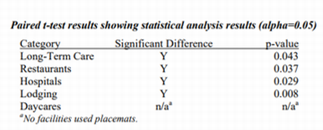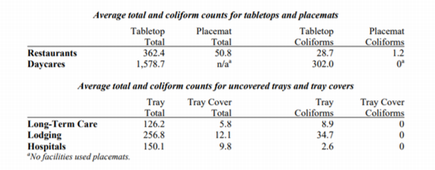Archives
Considerations in Making Environmental Marketing Claims
/in Publications and Reports, Stewardship ResourcesBenefits of Paper Placemat or Tray Cover Use in the Reduction of Bacterial Contamination in Selected Public Facilities: Executive Summary (Members Only)
/in SanitationExecutive Summary:
Benefits of Paper Placemat or Tray Cover Use in the Reduction of Bacterial Contamination in Selected Public Facilities
Conducted by the University of Wisconsin – Oshkosh
for the Foodservice & Packaging Institute, Inc.
INTRODUCTION
In 1979, a study documenting the sanitary benefits of paper placemats was conducted by the Food Protection Laboratory of the Syracuse Research Corporation. Results from this study demonstrated that placemats help in the reduction bacterial transfer from tabletops in restaurants. Similar results were found in a study conducted in 1997 by University of Wisconsin – Oshkosh’s Department of Biology and Microbiology.
The objective of the 2006 study, also conducted by the University of Wisconsin – Oshkosh was to expand upon the study conducted in 1997 to include new groups of facilities and products and a more detailed breakdown of the microorganisms present. In the restaurants and daycares the objective was to evaluate microbial loads on placemats versus uncovered tables. In long-term care facilities, lodging and hospitals tray covers were compared to uncovered trays. In all cases, the microorganisms examined were Bacillus, coliforms, Enterococcus, Micrococcus, Staphylococcus, Streptococcus, among others.
METHODOLOGY
Sampling was conducted from mid-January to mid-May 2006, and the protocol was followed from Standard Methods for the Examination of Dairy Products, 16th edition (1985). A total of twenty plates were used per facility, ten tabletop/tray surfaces and ten placemat/tray cover surfaces. If a location did not use placemats/tray covers just the tabletop/tray was sampled. Samples were usually collected mid-afternoon, following the lunch hour. The samples were collected by uncovering the Rodac® plate, inverting it, and stamping the agar on the sample surface. They were then transported to UW Oshkosh where they were incubated. Following the incubation period, plates were counted and identified by morphology.
RESULTS
A total of 50 facilities, in the five aforementioned groups, agreed to have their locations participate in this study. The daycare group did not have any placemat data due to the fact that none of the facilities contacted used placemats. Therefore, a total of 900 data points were collected.
Long-term care, restaurants, hospitals and lodging all showed a statistically significant difference between the samples that had placemats/tray covers when compared to samples that did not use this protective barrier.

While the daycare facilities had no statistics conducted due to the lack of placemats, these facilities had the highest levels over overall microbes and ten-times the amount of coliforms of the next highest facility group. Restaurants and lodging facilities were the next two groups with the highest levels of overall microbes and coliforms. The hospital and long-term care facilities demonstrated the least amount of overall microbes and coliforms.

While the placemats/tray covers were very successful as a barrier to overall bacterial contact, they were particularly effective as a barrier to coliforms. Additionally, there were much higher levels of Staphylococcus found in samples with no placemats/tray covers. Only one group (restaurants) showed any coliforms when the placemats were sampled.
DISCUSSION
This study shows similar results to the two previous studies mentioned in the Introduction. The placemats/tray covers provided an excellent barrier to the inadvertent contact with microorganisms at a number of facilities. Statistical analysis of the overall microbial means within each group showed a significant difference in all groups that had both covered and uncovered sites. Additionally, the daycare group did not use placemats, but likely could benefit from their use due to their relatively high level of microbes and coliforms. This overall lack of microbial contact would likely translate into a more sanitary environment, and consequently an environment that would be less likely to transmit disease causing microorganisms to unsuspecting users of these facilities. This principal is no more important than in a daycare where children lack the basic understanding of sanitation and personal hygiene.
Given the relatively low cost of these paper products they could be a value-added public health benefit to all these facilities. A cost-benefit analysis may be warranted to show operators of these facility types that the benefits of using placemats/tray covers far outweigh any additional costs to the facility. If more facilities used these barriers it would be an asset to environmental public health and may be able to prevent the spread of common illnesses.
